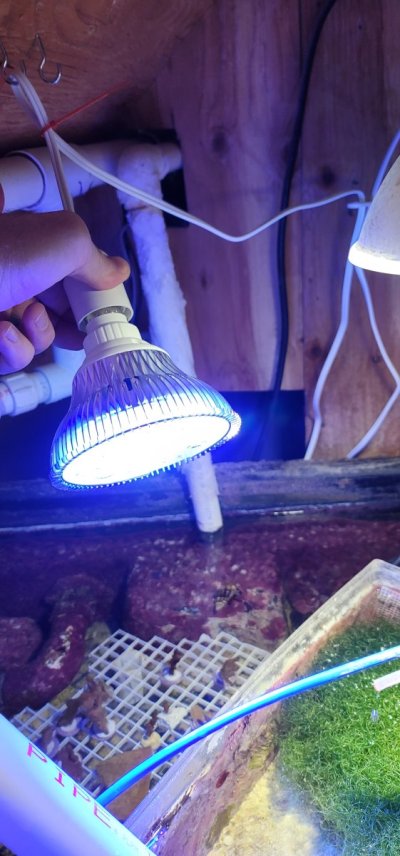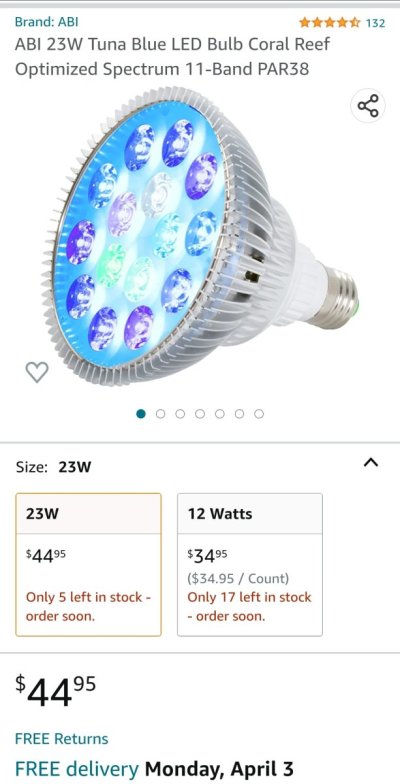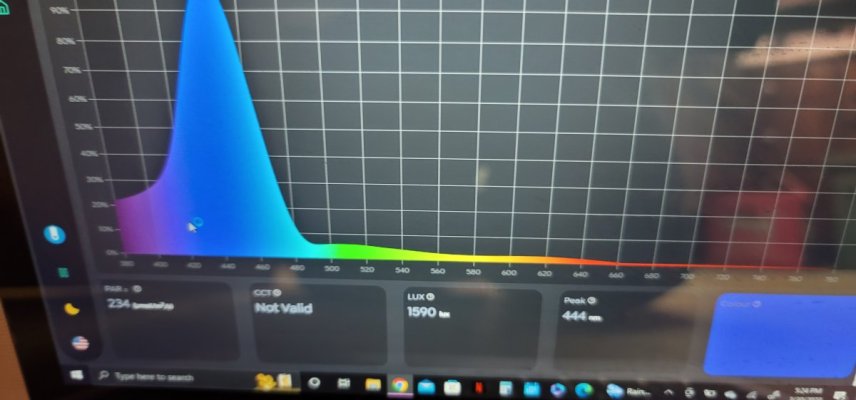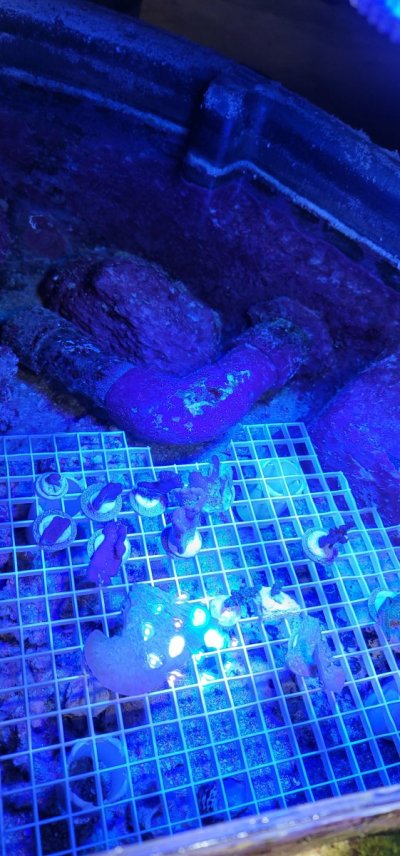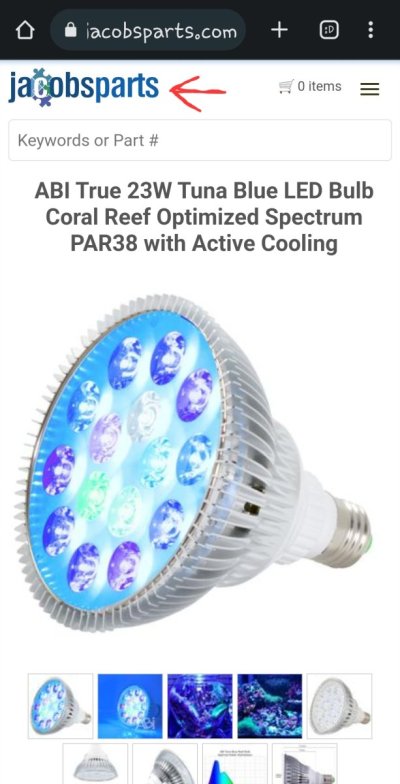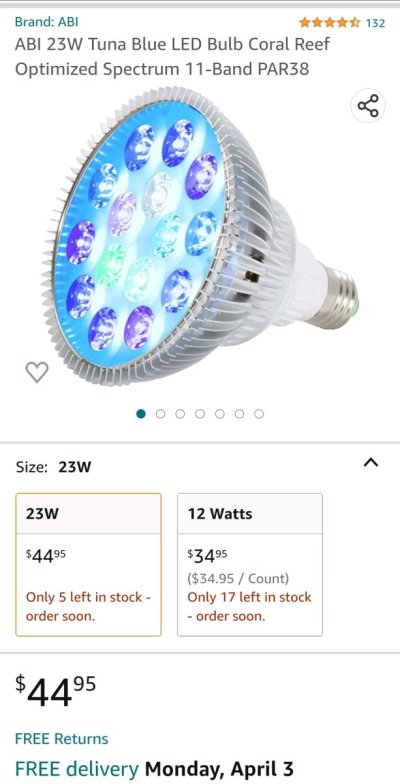Can someone explain why UV isn’t counted towards par with this device when apogee does? I got my parwise last week but have yet to try it out. If uv adds to par, how are we not frying corals up high in our tanks if we set the par to the parwise if it is 100 par lower than the apogee which I also have.
Navigation
Install the app
How to install the app on iOS
Follow along with the video below to see how to install our site as a web app on your home screen.
Note: This feature may not be available in some browsers.
More options
You are using an out of date browser. It may not display this or other websites correctly.
You should upgrade or use an alternative browser.
You should upgrade or use an alternative browser.
Parwise
- Thread starter miller75
- Start date
- Tagged users None
Hey ConsummatePro@ITCreefculture if you’re taking suggestions:
1. I like the idea of user-selectable PAR ranges (PARwise default, Apogee 510 matched, BRS biology band, etc) - it highlights the flexibility of the PARwise. It’s hard to argue with the track record of the Apogee 510 even if it somewhat over includes spectra. Or, offering this might just confuse everyone so maybe just stick to your convictions as to how you report PAR!
2. If we can’t yet save results to a file, can we add a label (a note field) on the screen so screenshots can include a note without needing to manually add a label? I had to do it manually and it was tedious to map my tank. The notes field could also be useful for an exported record, too.
3. As mentioned before, on a Kindle 7 and 8, the Silk browser tab and addressbar takes up valuable real estate. Being able to scroll those off the screen would give more space for the spectrum, PAR/lux/peak boxes, and a user note field.
4. Right now on the Kindle you have to rotate the tablet into landscape mode to show the spectrum etc and it’s harder to hold that way with one hand - I’d like to see a dynamic layout that can use the portrait aspect ratio yet still show all the data on the Kindle screen without needing to scroll.
In answer.
1. Doing things someone's not done is always a minefield - so I think the best approach is to stick to referenceable scientific literature and use the data from that. That's how we planned to move forward anyway.
2. You can press the pause button to 'pause' the reading so you can note it down, when on a P.C you can right click and save on the spectral graph/DLI etc to save it for future reference.
3. Noted - I will refer to our tech team to see if we can do anything about this - I get it too on my kindle - but hadn't particular bothered me. On other android devices where you use actual google chrome or microsoft edge, you get the option in the menu to 'install app' if it doesn't do it automatically..then you don't get this issue as it will go full screen. Also if you hit 'home' within the web app on amazon silk browser you can get all your main data points in portrait mode you just dont get to look at the spectrum at the same time - provided that's already set up - then this might be the best way to use it in the meantime.
4. I think there is too much info to squeeze into a small space - unless you need the spectrum - use the 'HOME' menu as this will display all the main data points in portrait mode. If you want spectrum its better to see it on a big graph. I'd be tempted to get my laptop out and use that for spectral measurements rather than general PAR measurements.
By scientific definition of PAR - Photosynthetically Active Radiation is any light wavelengths that fall between 400nm to 700nm. If its outside of this range - it shouldn't get counted and in some products it does - because they don't have the ability to ignore it. We can.Can someone explain why UV isn’t counted towards par with this device when apogee does? I got my parwise last week but have yet to try it out. If uv adds to par, how are we not frying corals up high in our tanks if we set the par to the parwise if it is 100 par lower than the apogee which I also have.
The sensor that Apogee have developed and published their response curve for - shows it picks up light outside of this range. You can check this with a a cheap UV black light off of amazon . There will be some visible light and PAR (we can see it) but the meat of the light that it outputs we cant as its outside of our visual range which also ends around 400nm.. So there shouldn't be very much PAR at all. This is of course only relevant if your light fixture actually outputs light outside of the PAR range.
When we tested this we also verified this with a lab spectrometer.
I think it boils down to that the technological advantage that we have with our sensor, we can completely ignore the light that doesn't meet the definition of PAR because we can accurately measure the spectrum and remove what shouldn't be there. We aren't just measuring the total light available through a filter. We hope to build on this in the future, as an example we could offer users the ability to measure the BRS biology band ONLY.. or a wider spectral range. Homework for us, for the future!
Whether light outside of the original scientific definition of PAR its relevant or not to corals is a different matter - that's why you must be able to see the spectrum too. A high PAR level can be 100% irrelevant for the coral if the light is all green, for example!
I also wouldn't rely on a single user feedback that A PARwise is 100 PAR lower than an apogee - even if it was in our favour - the Apogee model, age and device, light source type, position in water, device repeatability are all major factors here - including water parameters. We also have several apogee (MQ-510 included) and they all give us different readings. So take that with a pinch of salt. Our MQ-510 isnt '100' out across a range of lights we've tested.. for example.
We stand by our calibrated results
Kind regards
Craig
Thank you for being so open with the community. This thread, and your involvement had me order one, It should be her Friday. I'm excited to see more about the lighting of my tank.By scientific definition of PAR - Photosynthetically Active Radiation is any light wavelengths that fall between 400nm to 700nm. If its outside of this range - it shouldn't get counted and in some products it does - because they don't have the ability to ignore it. We can.
The sensor that Apogee have developed and published their response curve for - shows it picks up light outside of this range. You can check this with a a cheap UV black light off of amazon . There will be some visible light and PAR (we can see it) but the meat of the light that it outputs we cant as its outside of our visual range which also ends around 400nm.. So there shouldn't be very much PAR at all. This is of course only relevant if your light fixture actually outputs light outside of the PAR range.
When we tested this we also verified this with a lab spectrometer.
I think it boils down to that the technological advantage that we have with our sensor, we can completely ignore the light that doesn't meet the definition of PAR because we can accurately measure the spectrum and remove what shouldn't be there. We aren't just measuring the total light available through a filter. We hope to build on this in the future, as an example we could offer users the ability to measure the BRS biology band ONLY.. or a wider spectral range. Homework for us, for the future!
Whether light outside of the original scientific definition of PAR its relevant or not to corals is a different matter - that's why you must be able to see the spectrum too. A high PAR level can be 100% irrelevant for the coral if the light is all green, for example!
I also wouldn't rely on a single user feedback that A PARwise is 100 PAR lower than an apogee - even if it was in our favour - the Apogee model, age and device, light source type, position in water, device repeatability are all major factors here - including water parameters. We also have several apogee (MQ-510 included) and they all give us different readings. So take that with a pinch of salt. Our MQ-510 isnt '100' out across a range of lights we've tested.. for example.
We stand by our calibrated results.
Kind regards
Craig
Thanks Jeff! We're a small company and team and feedback like this means a lot to us!!Thank you for being so open with the community. This thread, and your involvement had me order one, It should be her Friday. I'm excited to see more about the lighting of my tank.
Thanks for that detailed reply, I’m gonna compare the two side by side but set my spectrum and par according to the parwise and see how it affects my corals…..
- Joined
- Dec 20, 2017
- Messages
- 174
- Reaction score
- 106
I found this bulb on Amazon and looked at the specs of the LEDs. Something about the spectrum output shown in the graph seems weird.
The specs claim that there is a dedicated LED emitting 490-495nm, but the spectrum graph doesn't seem to be showing it.
For comparison, the manufacturer also claims to have included a dedicated LED in the 395-400nm, and that light is clearly visible in the graph.
Is the bulb's product description deceiving, or is there some kind of error with the Parwise in the cyan spectrum range? Maybe the cyan LED is lower power than the others for some reason?
Last edited:
Craig,
I take offense to your statement of "take with a grain of salt 1 users statement of 100 PAR difference".
That "one user" was me using a brand new Apogee MQ-510, the latest model that reads LED and all aquarium lighting. It read 100 PAR difference in the 250W metal Halide fixtures and about 80 PAR difference in strictly LED.
You sent me a message and then recalled it on Facebook where your Apogee was showing about 60 or 70 PAR difference from your own Apogee MQ-510 vs the PARwise. The recalled message was a video you sent.
So if you're going to throw off on the person that gave you the most recommendations, that's all I need to hear. There would be no reason to unsend a message unless you're covering your tracks. You just forgot to unsend your text....

I take offense to your statement of "take with a grain of salt 1 users statement of 100 PAR difference".
That "one user" was me using a brand new Apogee MQ-510, the latest model that reads LED and all aquarium lighting. It read 100 PAR difference in the 250W metal Halide fixtures and about 80 PAR difference in strictly LED.
You sent me a message and then recalled it on Facebook where your Apogee was showing about 60 or 70 PAR difference from your own Apogee MQ-510 vs the PARwise. The recalled message was a video you sent.
So if you're going to throw off on the person that gave you the most recommendations, that's all I need to hear. There would be no reason to unsend a message unless you're covering your tracks. You just forgot to unsend your text....
I found this bulb on Amazon and looked at the specs of the LEDs. Something about the spectrum output shown in the graph seems weird.
The specs claim that there is a dedicated LED emitting 490-495nm, but the spectrum graph doesn't seem to be showing it.
For comparison, the manufacturer also claims to have included a dedicated LED in the 395-400nm, and that light is clearly visible in the graph.
Is the bulb's product description deceiving, or is there some kind of error with the Parwise in the cyan spectrum range? Maybe the cyan LED is lower power than the others for some reason?
We have bought some cheap LED sources off Amazon to play with, including a UVC Black light LEDs that say they're 365nm but actually they're 380nm - so specification and what actually gets used may vary! Verified with a lab calibrated spectrometer, not ours!
Worth noting as well, the response curve shown is the relative response in % of light being measure - so all those blue and violet LEDs are drowning out the 490-495 - most likely.
Last edited:
Hey Hurricane!Craig,
I take offense to your statement of "take with a grain of salt 1 users statement of 100 PAR difference".
That "one user" was me using a brand new Apogee MQ-510, the latest model that reads LED and all aquarium lighting. It read 100 PAR difference in the 250W metal Halide fixtures and about 80 PAR difference in strictly LED.
You sent me a message and then recalled it on Facebook where your Apogee was showing about 60 or 70 PAR difference from your own Apogee MQ-510 vs the PARwise. The recalled message was a video you sent.
So if you're going to throw off on the person that gave you the most recommendations, that's all I need to hear. There would be no reason to unsend a message unless you're covering your tracks. You just forgot to unsend your text....

Absolutely no offence intended mate! I think and hope that my message there was either poorly constructed or misinterpreted. I do apologise either way.
I am trying my utmost to help the community and support our products, even personally as you've seen I've messaged from my own personal Facebook page there! I am but one man to talk to the world
I think the main point I am trying to make is to ensure that anyone out there reading the thread won't think that a PARwise is always 100 PAR out vs an Apogee sensor because they won't be.
The spectrum has a massive effect on the result overall, with device to device measurement repeatability aside! Which we can see from my message is wide with my difference being 40 PAR. That's why spectrum is important to view it! I believe the 'PARwise is 100 out to Apogee' has already been echoed elsewhere by someone else .
The specifics of the situation and light source vary a lot! That comment was in no way meant as a slight against you Hurricane! You've been a hugely positive towards our product and thank you for being so active - I'm excited you've been able to get better growth after using PARwise too! So I do apologise if my post came across wrong.
Regards video sent - I reached out to you from my personal FB outside of work, for context purposes, later in our conversation I then mentioned that those videos were something I was able to grab in a store and were nothing official to publish. You responded with "Sure, I understand" and then I deleted them. I deleted those videos as these would have not been cleared by our team for use in the wider public. I'm not trying to cover any tracks - I just can't put anything out there that isn't cleared by our team, branding, content, marketing wise etc. But hopefully you can see I wasn't trying to cover any tracks - because I said there weren't official! If its the ones I remember, mine were quite close in reading under some Red Sea LEDs if I remember right?!
I didn't want the community to think that it was a generalised blanket thing.
A PARwise is likely never going to agree with Apogee simply because we can ignore parts of the spectrum they cant.
I hope that helps and goes someway to explain myself and of course, deleting unofficial videos send from a personal Facebook account.
Sorry again for any offence.
Kindest regards
Craig
- Joined
- Dec 20, 2017
- Messages
- 174
- Reaction score
- 106
I think it's definitely possible that the manufacturer of that bulb didn't actually use a 490-495nm LED. Perhaps what they think is 490-495 is actually 460-465. I could see that happening.We have bought some cheap LED sources off Amazon to play with, including a UVC Black light LEDs that say they're 365nm but actually they're 380nm - so specification and what actually gets used may vary! Verified with a lab calibrated spectrometer, not ours!
Worth noting as well, the response curve shown is the relative response in % of light being measure - so all those blue and violet LEDs are drowning out the 490-495 - most likely.
I have some heavy doubt that this could be the issue.
Firstly, this is exactly why I mentioned the violet diode. While there is only 1 LED in the 490-495nm range, there is also only 1 LED in the 395-400nm range as well. You can clearly see 395nm in the graph. The violet 395nm is about 3x as high as the cyan 495nm. Both with exactly one single dedicated diode. If the cyan is getting drowned out by the blue, why isn't the violet also getting drowned out?
Secondly, there is no dedicated green LED in that bulb at all. The only green is the green fraction coming from the single included 6500k white diode. it seems impossible to believe that the 6500k diode is putting out just as much green light at 520nm as a dedicated 490-495nm diode is putting out in it's entirety.
Yea, I don't feel good with that explanation at all. I'm pretty convinced that either something is deceptive with the bulb's description (such as using an LED with a different spectrum output from what they claim in the description), or something is going wrong in the spectrum graph.
- Joined
- Dec 20, 2017
- Messages
- 174
- Reaction score
- 106
I think I know what happened.We have bought some cheap LED sources off Amazon to play with, including a UVC Black light LEDs that say they're 365nm but actually they're 380nm - so specification and what actually gets used may vary! Verified with a lab calibrated spectrometer, not ours!
Worth noting as well, the response curve shown is the relative response in % of light being measure - so all those blue and violet LEDs are drowning out the 490-495 - most likely.
This bulb manufacturer has two products that look very similar. It has a "Tuna Blue" bulb that includes the cyan spectrum, and a "Blue and White" bulb that does not contain any cyan spectrum diodes.
The person who said they bought the bulb included a screenshot of the "Tuna Blue" product listing. However, the spectrum he measured matches almost exactly with the expected spectrum of the "Blue and White" product.
So either they received the wrong product, or they included the wrong screenshot.
Mystery solved I guess. My apologies for casting suspicion on your product.
Hmmm, could be. The box did say tuna blue but all these bulbs that are hardly used in the hobby could be all the same. I'm not putting much faith in the bulb or the spectrum they claim to put out.I think I know what happened.
This bulb manufacturer has two products that look very similar. It has a "Tuna Blue" bulb that includes the cyan spectrum, and a "Blue and White" bulb that does not contain any cyan spectrum diodes.
The person who said they bought the bulb included a screenshot of the "Tuna Blue" product listing. However, the spectrum he measured matches almost exactly with the expected spectrum of the "Blue and White" product.
So either they received the wrong product, or they included the wrong screenshot.
Mystery solved I guess. My apologies for casting suspicion on your product.
I just wanted to test it and see if it will grow anything. So far I managed to burn some frags. I raised the bulb up some in hopes to get some color back in the frags. Time will tell.
- Joined
- Dec 20, 2017
- Messages
- 174
- Reaction score
- 106
I'm pretty sure they sent you the wrong bulb then.Hmmm, could be. The box did say tuna blue but all these bulbs that are hardly used in the hobby could be all the same. I'm not putting much faith in the bulb or the spectrum they claim to put out.
I just wanted to test it and see if it will grow anything. So far I managed to burn some frags. I raised the bulb up some in hopes to get some color back in the frags. Time will tell.
This is what I found for the expected output of the Tuna Blue variant.
This is the expected output of the "Blue and White" variant
I would be excited to get the "Tuna Blue", it looks like a great bulb. The "Blue and White" looks extremely disappointing in comparison.
You raised a really relevant point though - if the overaching dominating output is massively blue.. that green is going to get washed out anyway! But indeed looks like a different product. Perhaps without PARwise you'd have never of known! Although from the picture it looks like you can see one of the diodes is green? Can you see that on your one?I think I know what happened.
This bulb manufacturer has two products that look very similar. It has a "Tuna Blue" bulb that includes the cyan spectrum, and a "Blue and White" bulb that does not contain any cyan spectrum diodes.
The person who said they bought the bulb included a screenshot of the "Tuna Blue" product listing. However, the spectrum he measured matches almost exactly with the expected spectrum of the "Blue and White" product.
So either they received the wrong product, or they included the wrong screenshot.
Mystery solved I guess. My apologies for casting suspicion on your product.
I'm at work right now but I'll look when I get home!You raised a really relevant point though - if the overaching dominating output is massively blue.. that green is going to get washed out anyway! But indeed looks like a different product. Perhaps without PARwise you'd have never of known! Although from the picture it looks like you can see one of the diodes is green? Can you see that on your one?
But you are right, it looks like blue light but the spectrum tells a different story.
Edit: Amazon can not guaranteed a tuna blue light if I send it back for a new one.
LOL, PARwise might be a game changer in how lighting companies Market their bulbs. They're going to have to start backing up what they claim with everybody having a spectral analyst in their toolbox.
Love it!
Last edited:
- Joined
- Dec 20, 2017
- Messages
- 174
- Reaction score
- 106
You might be able to reach out to the seller directly and explain the situation. These bulbs appear to be sold on Amazon by a company called JacobsParts. They also sell those same bulbs directly through their website. The contact information listed on their website is [email protected].I'm at work right now but I'll look when I get home!
But you are right, it looks like blue light but the spectrum tells a different story.
Edit: Amazon can not guaranteed a tuna blue light if I send it back for a new one.Then they came back and said that I can only get a refund after I said I did an analysis of the bulb.
LOL, PARwise might be a game changer in how lighting companies Market their bulbs. They're going to have to start backing up what they claim with everybody having a spectral analyst in their toolbox.
Love it!
- Joined
- Dec 20, 2017
- Messages
- 174
- Reaction score
- 106
I assumed that was the same company selling in both places.
See the "Sold By" name in the amazon listing:
Are you saying that the company selling on Amazon isn't the real JacobsParts, but instead some kind of impersonator selling imitation bulbs?
Same seller.I assumed that was the same company selling in both places.
See the "Sold By" name in the amazon listing:

Are you saying that the company selling on Amazon isn't the real JacobsParts, but instead some kind of impersonator selling imitation bulbs?
I guess I'm saying this is the tuna. Just the spectrum is misrepresented.
I won't know for sure until I get home and physically look at each led.
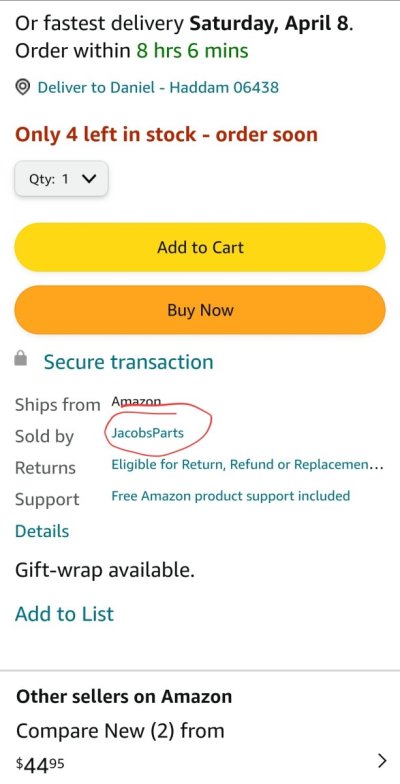
Similar threads
-
- AMS: Article
- Replies
- 11
- Views
- 1,378
- Replies
- 8
- Views
- 412






